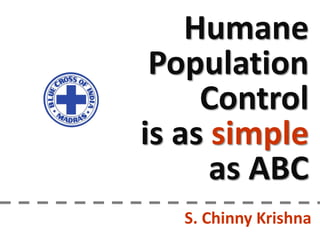TEDxChennai 2010 - Dr. Chinny Krishna on Humane Population Control is as simple as ABC
- 1. Humane Population Control is as simple as ABC S. Chinny Krishna
- 3. How do we respond to the Street dog issue?
- 4. Catch. Kill. 100 1860 16000 1964
- 6. WE Influence Educate Ignore Holding Capacity Register Breeders Kill Spay/Neuter
- 7. What happens if we ignore? Common logic implies that the number of animals will keep increasing since dogs and cats are prolific breeders.
- 8. However, in reality The numbers will level off at the Holding Capacity of the area
- 9. What is Holding Capacity? number It is the of animals that an area can support depending on
- 10. What happens if we kill? Numbers Remaining animals have increase again Higher survival rate An immediate drop in the numbers Numbers level off when Holding capacity is reached
- 11. Why is ‘Catch-and- Kill’ preferred? It is believed that ‘Catch-and-Kill’ is Cheaper than other methods
- 12. Catch. Kill. Repeat. 100 1860 16,000 1964 30,000 1996
- 13. Did killing help? Incidents of Rabies didn’t decrease, No. neither did the number of dogs on the streets. In 1996, there were 120 deaths from Rabies in Chennai alone.
- 15. Our Biggest Problem Signed: S. Chinny Krishna(Publisher) Dated: 30-6-1966
- 16. “We can stop the cruelties of surplus animal breeding at any time. Only the will is needed. “ The Blue Cross of India will be soon starting a free spaying centre. All we need is Rs. 25000. You, if you will, can help us solve this problem.
- 17. In 1966, after much study, Blue Cross of India proposed that street dog population control is as easy as…
- 19. 1990
- 20. All too often, authorities confronted with the problems caused by these dogs have turned to mass Dr. K. Bogel destruction in the hope Chief Veterinary, of finding a quick solution, Public Health Unit , only to discover that the WHO, Geneva, Switzerland destruction had to continue year after year with no end in sight.
- 21. Insanity is doing the same thing over and over again, expecting different results
- 22. Animal Birth 1996 Control starts city wide 30 years after the Blue Cross proposed ABC and 29 years after opening our first ABC in several cities centre.. in India
- 23. Seeing positive results 1997 General A.K. Chatterjee, Chairman, Animal Welfare Board Of India (AWBI) has Animal Birth Control (ABC) adopted as the policy of the AWBI.
- 24. 2001 Reviewing the success of ABC in places where it had been implemented as a pilot project, The Government of India introduced new regulations which stopped killing of street animals and replaced it with ABC
- 25. - Number of Rabies cases is more or less constant over 2004 a 10 year period from 1992 to 2002 at 17371 cases per year The WHO sponsored study of Rabies in India - Number of animal from 1993 to 2002 bites(mostly dogs) is also reveals.. constant over the same period
- 26. Rabies cases in However humans as well as the incidence of ..in areas dog bites shows where a dramatic drop.. ABC-AR is being implemented aggressively
- 27. No. of Rabies Deaths: Jaipur(Walled city) ABC-AR starts in March ’96 10 10 9 8 7 5 3 2 1 1992 1993 1994 1995 1996 1997 1998 1999 2000 2001 2002 2003 2004
- 28. No. of Rabies Deaths: Chennai 120 107 City-wide ABC-AR starts in September ’96 44 35 24 17 16 5 5 1996 1998 2000 2002 2004 2006
- 29. No. of Rabies Deaths/Dog Bites: Kalimpong 10 230 ABC-AR starts in 2000 D R O A G B 5 I B E I S T E 26 25 0 0 0 S 2000 2001 2002 2000 2001 2003 2004 2002
- 30. The Blue Cross Success Story
- 31. In Chennai, zero rabies cases since Jan 2008.
- 32. In Jaipur, the incidence of rabies in ABC areas has been zero since 2001 as against 8.75 deaths per year during the five years prior to 1996 when the full fledged ABC programme started.
- 33. In Kalimpong, zero deaths since 2002 as against 10 per year previously.
- 34. In Bangalore, both dog bites and rabies cases have gone down sharply since October 2000 when the programme began.
- 35. The Government of India accepts the recommendation 2010 to propose two new rules under the Prevention of Cruelty to Animals Act of After many years 1960: The Pet Shop of persuasion.. Regulation Rules and The Breeding and Sale of Pets Rules
- 36. Thank You




































